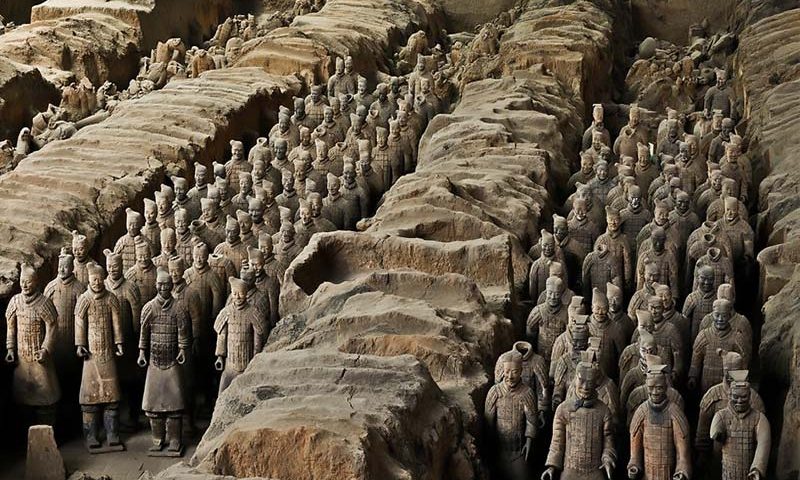Terracotta Army: The Dead Army of Qin Shi Huang, First Emperor of China

Should you consider jewellery as an investment?
9th October 2017
Gemstone of the Week: Morganite
13th October 2017One of China’s most famous attractions, The Terracotta Army consists of thousands of life-sized warriors found 35 metres under the earth’s surface. Not only does the collection include the soldiers themselves, it also features a selection of horses, chariots and even non-military figures such as acrobats, musicians and strongmen. Believed to have been built by Emperor Qin Shi Huang, the first Emperor of China, the life-like army remained undiscovered for over 2200 years. In this article, we will explore the stupendous archaeological find in more detail, looking deeper into the history, beliefs and myths that lie behind the Terracotta Army.
What is the Terracotta Army?
Depicting the armies of Emperor Qin Shi Huang, today the collection of terracotta sculptures is one of the biggest tourist attractions in the whole of China. The army was believed to have been buried with the emperor when he passed away in 201 BCE, with the purpose of protecting him in his afterlife.
First discovered in 1974, the collection lay undiscovered for over 2000 years, before being stumbled across by local farmers in Lintong District whilst they were digging a water well. All life-sized, the figures vary in height depending on their roles; the tallest sculptures in the collection are thought to be the generals. By 2007, 3 main pits had been discovered, estimated to contain over 9000 soldiers, horses, and chariots. Whilst some of these have managed to be extracted from the pits, it’s believed that the majority of the warriors still remain underground, buried deep in the pits near Qin Shi Huang’s mausoleum.
So, how does a collection of sculptures this immense stay undiscovered for thousands of years? It believed that the people that created the army were enslaved by Emperor Qin for the entire duration of the process. Once the extravagant masterpiece was complete and buried from view, all of the individuals were killed in order to stop the location from being revealed; the number of deaths is thought to average around 700,000.
History and Origins
Work on the Terracotta army is thought to have begun soon after Emperor Qin ascended the throne. At this point, the young emperor was just 13 years old. Beginning in 246BCE, the project ended up accumulating over 700,000 workers, all enslaved for the duration of the 38 years it took to complete the collection. The location for the burial was thought to have been chosen based on its aesthetic appeal, famous throughout China for its beautiful landscape covering mines of gold and jade. In addition to the terracotta sculptures, the emperor was believed to have been buried with a selection of other valuable artefacts including family heirlooms and extravagant gemstone jewellery.
The army was discovered in March 1974, stumbled across by a group of farmers digging a water well. While the farmers were digging a fair distance away from the tomb of the emperor, at the beginning of the process they were unaware of the vast mausoleum, stretching far beyond the direct site of the tomb. Prior to discovering, occasional pieces of terracotta fragments were reported to have been found, but people brushed them off instantly expecting them to be usual everyday items such as bricks and roofing materials. It wasn’t until the small discovery from the local farmers that archaeologists investigated further, ultimately finding a collection of immense pits housing the largest terracotta figurine collection in the world. Since the discovery, a museum has been created around the area, keeping the figures in their original pits to retain as much of the original creation as possible.
The Pits
To date, three main pits have been evacuated, all of which were approximately 7 metres deep. With their whole purpose believed to have been to protect the emperor in his afterlife, interesting enough the warriors were placed in the pits facing the east, the exact direction of the states that the emperor had previously conquered. Currently, pit one is thought to contain the majority of the army, housing over 6000 sculptures in total. With the immense length of 230 metres, the pit was found to include 11 corridors each supported with traditional beams and paved with brick. When built, this design would have been similar to that of palaces, making it a popular choice for tombs of the rich and royals of society.
Beliefs and Myths
Although a small percentage of the collection has been uncovered, the majority of the sculptures are thought to remain underground. Rumour has it that when Emperor Qui had the Terracotta Army buried, he ordered channels of Mercury to be run throughout the pits, ensuring that anyone that discovered the collection would be greeted with a dangerous and toxic gas. While some of the army has been uncovered with minimal issues, scientific studies have indicated that high levels of mercury exist in the soil closer to the tomb, making it too risky to uncover the rest of the collection, just yet. Until scientists have figured out a safe way to open the chamber, the rest of the Terracotta Army will, unfortunately, have to remain underground.
When the warriors were first evacuated from the pits they were beautifully painted in vibrant full colour, but as they have been exposed to the air, the colours have almost completely disappeared. Consequently, even in the areas that warriors were extracted from previously, some of the collection still lays buried – hoping to prevent further loss of colouring.
In Summary
According to recent studies, scientists may be well on their way to being able to safely extract the remainder of the Terracotta Army; keeping this in mind, over the next couple of years China could see their famous tourist attraction increase dramatically in numbers. With the incredible museum potentially soon housing the entire collection of 9000 figurines, it’s no wonder that the ancient city is still so popular today.




